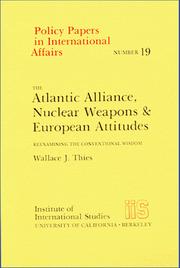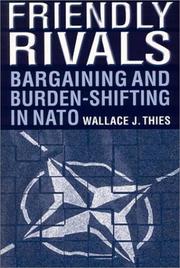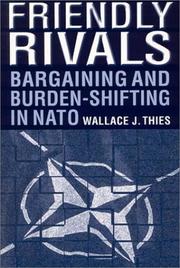| Listing 1 - 7 of 7 |
Sort by
|
Book
ISBN: 0520039629 Year: 1980 Publisher: Berkeley (Calif.) : University of California press,
Abstract | Keywords | Export | Availability | Bookmark
 Loading...
Loading...Choose an application
- Reference Manager
- EndNote
- RefWorks (Direct export to RefWorks)
Conflit vietnamien --- Guerre du Viet-nam, 1961-1975 --- Vietnam War, 1961-1975 --- Vietnamees conflict --- Vietnamese conflict --- Vietnamoorlog, 1961-1975 --- Vietnam War, 1961-1975. --- Diplomatic history. --- Diplomatic history

ISBN: 0877255199 9780877255192 Year: 1983 Volume: 19 Publisher: Berkeley: Institute of International Studies, University of California,
Abstract | Keywords | Export | Availability | Bookmark
 Loading...
Loading...Choose an application
- Reference Manager
- EndNote
- RefWorks (Direct export to RefWorks)
Nuclear weapons --- Intermediate-range ballistic missiles --- Cruise missiles --- North Atlantic Treaty Organization --- Nuclear weapons. --- Intermediate-range ballistic missiles. --- Cruise missiles. --- North Atlantic Treaty Organization. --- Otan --- Armes nucleaires --- Pacifisme --- Europe
Book
ISBN: 9780521749794 9780521767293 9780511627002 Year: 2009 Publisher: Cambridge Cambridge University Press
Abstract | Keywords | Export | Availability | Bookmark
 Loading...
Loading...Choose an application
- Reference Manager
- EndNote
- RefWorks (Direct export to RefWorks)
#SBIB:327.7H32Bondgenootschappen: NAVO / NATONATO. --- Organización del Tratado del Atlántico Norte --- Organizat︠s︡ii︠a︡ severoatlanticheskogo dogovora --- Orhanizat︠s︡ii︠a︡ pivnichnoatlantychnoho dohovoru --- Organisation Traité Atlantique Nord --- Severoatlanticheskiĭ blok --- Noord Atlantische Verdrags-Organisatie --- Organisation du Traité de l'Atlantique-Nord --- Organismos Boreioatlantikou Symphōnou --- Atlantic Alliance --- North Atlantic Treaty Organisation --- Organizzazione del Trattato dell'Atlantico del Nord --- Északatlanti Szövetség --- Atlantisch Bondgenootschap --- Noord-Atlantisch Bondgenootschap --- Atlanshafsbandalagið --- N.A.T.O. (North Atlantic Treaty Organization) --- NATO (North Atlantic Treaty Organization) --- OTAN (North Atlantic Treaty Organization) --- N.A.V.O. (North Atlantic Treaty Organization) --- NAVO (North Atlantic Treaty Organization) --- Kuzey Atlantik Andlaşması Örgütü --- O.T.A.N. (North Atlantic Treaty Organization) --- Organizacja Paktu Północnoatlantyckiego --- Nordatlantisches Bündnis --- Atlantisches Bündnis --- Organisation des Nordatlantikvertrages --- Atlantische Allianz --- North Atlantic Alliance --- Alliance de l'atlantique nord --- Organizacja Traktatu Północnoatlantyckiego --- Patto atlantico --- Ḥilf Shamāl al-Aṭlanṭī --- Organização do Tratado do Atlântico Norte --- Ḥilf al-Aṭlasī --- Alleanza atlantica --- NATO --- #SBIB:327.7H32 --- Bondgenootschappen: NAVO / NATO --- NATO. --- Pohjois-Atlantin liitto --- North Atlantic Treaty Organization. --- North Atlantic treaty organisation --- North Atlantic Treaty Organization --- NAVO --- OTAN

ISBN: 0765610167 Year: 2003 Publisher: Armonk, NY : Sharpe,
Abstract | Keywords | Export | Availability | Bookmark
 Loading...
Loading...Choose an application
- Reference Manager
- EndNote
- RefWorks (Direct export to RefWorks)

ISBN: 1317470125 0765610175 1315704196 9781317470120 9780765610164 0765610167 9780765610171 9781315704197 9781317470106 9781317470113 1317470117 Year: 2015 Publisher: London
Abstract | Keywords | Export | Availability | Bookmark
 Loading...
Loading...Choose an application
- Reference Manager
- EndNote
- RefWorks (Direct export to RefWorks)
Viewing the behavior of NATO members through the prism of bargaining theory reveals them as states intent on obtaining the benefits of membership at the least cost to themselves. This book shows how NATO members use a variety of strategies and tactics to try to get the better of each other without wrecking an alliance that realizes their shared goals and from which they all benefit. The book examines: the original design of the alliance; patterns of bargaining during the Cold War and post-Cold War periods; how their rivalries impact members' domestic policies of defense and welfare; and what t
North Atlantic Treaty Organization. --- NAVO --- OTAN --- North Atlantic treaty organisation --- North Atlantic Treaty Organization
Book
ISBN: 1107194466 0511699115 051164700X 9786612393051 1282393057 0511627009 0511593031 0511651082 0511592108 0511594968 0521767296 0521749794 Year: 2009 Publisher: New York : Cambridge University Press,
Abstract | Keywords | Export | Availability | Bookmark
 Loading...
Loading...Choose an application
- Reference Manager
- EndNote
- RefWorks (Direct export to RefWorks)
Why NATO Endures examines military alliances and their role in international relations, developing two themes. The first is that the Atlantic Alliance, also known as NATO, has become something very different from virtually all pre-1939 alliances and many contemporary alliances. The members of early alliances frequently feared their allies as much if not more than their enemies, viewing them as temporary accomplices and future rivals. In contrast, NATO members were almost all democracies that encouraged each other to grow stronger. The book's second theme is that NATO, as an alliance of democracies, has developed hidden strengths that have allowed it to endure for roughly 60 years, unlike most other alliances, which often broke apart within a few years. Democracies can and do disagree with one another, but they do not fear each other. They also need the approval of other democracies as they conduct their foreign policies. These traits constitute built-in, self-healing tendencies, which is why NATO endures.
North Atlantic Treaty Organization. --- North Atlantic treaty organisation --- North Atlantic Treaty Organization --- NAVO --- OTAN --- Social Sciences --- Political Science
Book
ISBN: 150174948X 1501749501 1501749498 9781501749490 9781501749506 9781501749483 Year: 2020 Publisher: Ithaca
Abstract | Keywords | Export | Availability | Bookmark
 Loading...
Loading...Choose an application
- Reference Manager
- EndNote
- RefWorks (Direct export to RefWorks)
'Why Containment Works' examines the conduct of American foreign policy during and after the Cold War through the lens of applied policy analysis. The book argues that the Bush Doctrine after 2002 was a theory of victory. The text contrasts prescriptions derived from the Bush Doctrine with an alternative theory of victory, one based on containment and deterrence, which US presidents employed for much of the Cold War period.
Balance of power. --- Deterrence (Strategy) --- Military policy --- Psychology, Military --- Strategy --- First strike (Nuclear strategy) --- Nuclear crisis stability --- Power, Balance of --- Power politics --- International relations --- Political realism --- United States --- Foreign relations --- Philosophy. --- Libya --- Iraq --- Iran --- Defense, Military srategy, Preemptive war, Preventive war, Coercive diplomacy.
| Listing 1 - 7 of 7 |
Sort by
|

 Search
Search Feedback
Feedback About UniCat
About UniCat  Help
Help News
News